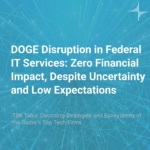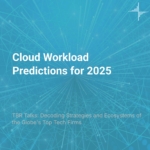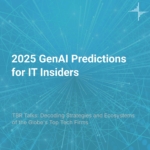DOGE Disruption in Federal IT Services: Zero Financial Impact, Despite Uncertainty and Low Expectations

TBR’s Public Sector Senior Analyst John Caucis joins the podcast to share how the very real concerns have led to net-zero impact on federal systems integrators’ financial performance in the last fiscal quarter, with some leading services firms revising guidance upward. Are the fears going to be substantiated into the next fiscal quarter, or will demand for IT modernization within the U.S. federal government remain?
Public Sector Analyst James Wichert also joins Patrick this episode for a discussion on the realities of Department of Government Efficiency’s impact on vendors and the market.
Listen and learn with TBR Talks!
Submit your Key Intelligence Questions for Patrick and his guests
Connect with Patrick on LinkedIn
Connect with John on LinkedIn
Connect with James on LinkedIn
Learn more about TBR at https://tbri.com/
TBR Talks is produced by Technology Business Research, Inc.
Edited by Haley Demers
Music by Burty Sounds via Pixabay
Art by Amanda Hamilton Sy
DOGE Disruption in Federal IT Services: Zero Financial Impact, Despite Uncertainty and Low Expectations
TBR Talks Host Patrick Heffernan: Welcome to TBR Talks. Today we have a special bonus episode with John Caucis and James Wichert to talk about what’s happening in the federal space.
Upcoming and existing analysis
John Caucis, TBR Senior Analyst: Thanks Patrick, there’s a lot going on. As I’m sure everyone’s aware, there’s no shortage activity these days as the Trump administration and their Department of Government Efficiency has and continues to upend the market. Where we stand right now with our research in the federal IT market, we’ve published three special reports over the last several weeks, detailing first the sphere of companies that we track, systems integrators or FSIs as we call them, federal systems integrators, how we see them positioned to contend with the challenges stemming from DOGE, the Department of Government Efficiency, how we see them in terms of strengths and weaknesses, areas of opportunities. That was our first special report. We followed that up now with a series of reports that we’re- a series of blogs, I should say, that we’re going to refer to as the DOGE Impact Series, the first two of which, and they’re following the earnings cycle of the companies that we track in federal IT, the first two blogs, went to press recently. SAIC released their fourth quarter earnings a couple of weeks ago, and we put together our thoughts on the impact of DOGE on SAIC, which I’ll talk more about in a few minutes, as well as Accenture. Accenture Global released their earnings for, I believe, what’s essentially the first calendar quarter of 2025, their fiscal year is somewhat offset the calendar. So, we got some insight from them on how DOGE is affecting their federal business. So, you can expect to see additional blogs come out, you know, within a week or two of the company earnings. We already know when General Dynamics, for example, is going to be releasing their next earnings. CACI will be around the same week, this is in and around the week of the 21st of April. So that’s upcoming.
What have we seen so far
What we have seen thus far: zero impact. And our next federal benchmark will be out in about a week or so, covering the fourth calendar quarter of 2024. And there was for all intents and purposes, zero real impact on the companies aside from the uncertainty that has descended upon the market. We didn’t see any impact financially. None of the companies that we track, you know, they’re still on track, Booz Allen and CACI and none of the companies that reported their fourth quarter earnings dialed down any aspect of their earnings, growth or profit wise, as a result of expectations with respect to DOGE. In fact, Booz Allen, CACI, they elevated their guidance for their fiscal 25. Booz Allen’s fiscal 25 just ended on the 31st of March, CACI’s fiscal runs to June 30th. We haven’t heard although we will be keeping an eye, obviously, on their first quarter results to see if that changes. So, no impact in the fourth quarter aside from the election itself. And, you know, the qualitative uncertainty that has descended upon the market.
James Wichert, TBR Analyst: I think based on our last podcast discussion, all of my vendors had already shared their earnings. So, not too much to talk about on that front updates wise. But what I would say is interesting is now that the quarter is over, and I’ve been filling out reports and everything, it would seem like award activity slowed down in the first quarter compared to prior years. And, you know, maybe that’s part of the uncertainty with DOGE. I would certainly say the newsrooms for several companies have slowed down. They’re less willing to share information at this point. Like, John said, a lot of the tangible disruptions, like, you’re not going to see it in 4Q and we’ll certainly hear about it in this upcoming earnings cycle. I think the tangible disruptions to a lot of vendors, and they’re certainly undergoing chaos, but it won’t be as drastic as I think a lot of people are thinking. So, looking at all the contracts that have been canceled, Peraton’s had something like $20 million canceled just in the first quarter. It was all work with, I think it was the CDC. And then you dig into that, but it was like the total contract value of all their opportunities canceled. But then you dig into it and each of the contracts are already largely done. Most of the funds are already obligated. And then, you know, that’s a similar story with a lot of the other vendors I track, like, you know, the total contract value is like, you know, relatively high, you’ll see like $100 million for some of them. And then you dig into it, and a lot of these contracts are already, you know, the work’s been largely completed. You know, most of the funds are obligated. So, you’ll certainly see an impact.
And, you know, maybe some guidance’s, I know some people elevated their guidance in the last quarter. Maybe we see a little pullback on that just given all the uncertainty all around, but I think the tangible disruption for several of these vendors, it’s not going to be the -10% or something that the market’s expecting for this quarter.
John: But ICF, James, I believe is one of the companies that had dialed down its guidance.
James: Yes.
John: But did they or did they not cite DOGE as a reason for that or?
James: So, for ICF dialing down their guidance, a lot of that was at the time USAID was being heavily disrupted and they already had some substantial- like, ICF is one of the smaller vendors we cover, and so, they had like an over $100 million contract with USAID to do, I think it was demographic surveys, and that alone got caught up in that, they had additional work with USAID. So, it significantly messes with their estimates for the federal part of the business. There’s also the uncertainty of a large part of DOGEs disruptions have been in the federal health space, which is pretty much where a huge chunk of ICF’s federal business is. I think 25% of it in 2024 was HHS alone. So, for them, the worst case is 10%. Assuming, all their big fears come true. I think their best case they were saying was flat. And I think Maximus was in a similar spot. Not nearly as drastic, though. So, I think Maximus is forecasted maybe, and, you know, correct me if I’m wrong, I think it was plus 1% and then -3% overall. But the federal business wasn’t expected to drive it down at the time.
And, all right, this is certainly like a tricky situation. There’s a ton of uncertainty and everything’s changing from day to day. I mean, the big update I saw like a day or two ago was Musk maybe taking a step back from DOGE and, you know, his, like, special government employee status is set to expire around May or June. And, you know, they believe they’ll be able to reduce the US deficit by like $1 trillion in that time frame. And then now very recently he’s like, it was either last night or this morning, he’s saying like it’s not happening. It’s fake news. But it is an interesting situation, like what happens next if he does go away, what happens to DOGE. And you know, if the department does stick around, that Hulk Smash approach, it’s nearly over. It could really be an opportunity for consultants and FSIs to get in there and start working with them. There’s only so much they can probably hack away at from agencies’ budgets and, Patrick, I know you’ve talked about how government is services before, and if you cut government you cut services. So, when you cut government spending, you’re saying essentially that service isn’t worth it. And at this point, maybe the vendors have a chance, if he does step away and DOGE sticks around, and it’s changing its approach. It does have a way to pinpoint the remaining areas to trim down on spending, but the bigger opportunity would be how they can offer modernization services that enable operational efficiency. You know, especially it’s like tens of thousands of employees, if not like hundreds of thousands of federal workers are, you know, their jobs are cut. And HHS has already begun the process of slashing 10,000 jobs.
Patrick: Yeah. I’m glad you said the word uncertainty 4 or 5 times there. And that’s exactly where we’re at. John, any other last thoughts?
John: Well, James makes a good point with respect to what services are expendable, what services aren’t. I think that’s still up in the air. And he makes another good point that I want to dovetail on, which is the amount of modernization work that still needs to happen. Yes. Five years ago, the pandemic really put the spotlight on the need, the dire need in the civil space, in many cases for IT modernization. The DoD, the intelligence community, they’ve been much more- they’ve been ahead of the game in terms of modernizing, as you would expect. You know, we have nation state rivals that we need to stay ahead of, or at least on par with technologically. And so, they’re much more mature when it comes to cloud computing when it comes to AI, GenAI, agentic AI, quantum computing, etc. But even with the acceleration and modernization that the pandemic drove, it sped up what was already a snail’s pace in terms of the speed of modernization. It did speed that up somewhat, but not- there’s still so much work that needs to be done. I mean, it’s hard to gauge that.
Patrick: Right.
John: But, if you- one way of perhaps looking at this is if you look at the federal IT budget in the last year of the Trump administration 1.0, it was about $92 billion. In the last year of the Biden administration, it was roughly, I think, with the numbers that we’re seeing now, are between and $130 and $135 billion. The increase over that four-year period is roughly $85 billion. If you look at the increase in cloud spending, it’s not following the same trajectory. So, we’re trying to figure out, well, where did that $85 billion in additional spending go? Did it go to people? Did it go to technology. Did it go to software and hardware? And maybe that’s what DOGE has been looking at, you know, saying we had expected, you know, greater investment in technology, hardware, software. And we know that there has been some certainly, you know, certainly in the DoD and the intelligence community. But has there been enough investment there, or has it just been you investing in expanding IT staffs? We don’t know. That’s another area of uncertainty. But the bottom line is this, the volume of modernization work is still- there’s still a lot that needs to be, and there’s a lot of work to be done there.
Patrick: Right, that’s super helpful John because it’s sort of putting- there’s how the federal government has to actually continue to operate, you know, things that- you still gotta keep the lights on, you still gotta pay the bills. And then there’s the federal government actually does need to modernize a lot of its IT systems. And then to James’s point about, you know, flat or, you know, the worst-case scenario for a lot of these companies, that middle section that I just said, that modernization, that’s going to provide them with the opportunity even if there’s chaos and uncertainty in terms of everything else going on.
Final thoughts
So, gentlemen, thank you very much. We will do this again, I suspect, in the near future because change is constant at the moment and chaos rules. So, talk to you guys, probably in a couple of weeks.
John: Thank you.
James: Sounds good.
TBR Talks: Decoding Strategies and Ecosystems of the Globe’s Top Tech Firms
Join TBR Principal Analyst Patrick Heffernan weekly for conversations on disruptions in the broader technology ecosystem and answers to key intelligence questions TBR analysts hear from executives and business unit leaders among top IT professional services firms, IT vendors, and telecom vendors and operators.
“TBR Talks” is available on all major podcast platforms. Subscribe today!

 Technology Business Research, Inc.
Technology Business Research, Inc. Technology Business Research, Inc.
Technology Business Research, Inc. Technology Business Research, Inc.
Technology Business Research, Inc.